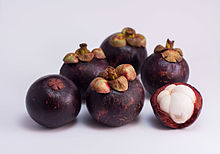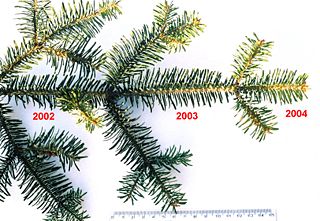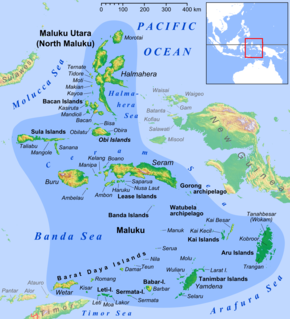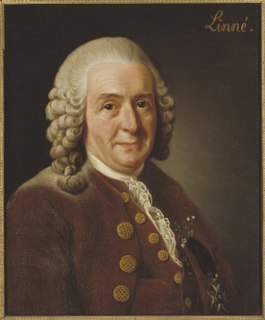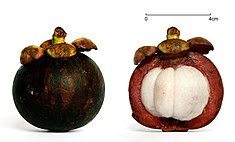
Pluots, apriums, apriplums, or plumcots, are some of the hybrids between different Prunus species that are also called interspecific plums. Whereas plumcots and apriplums are first-generation hybrids between a plum parent, and an apricot, pluots and apriums are later-generations. Both names "plumcot" and "apriplum" have been used for trees derived from a plum seed parent, and are therefore equivalent.

Mangoes are juicy stone fruit (drupe) from numerous species of tropical trees belonging to the flowering plant genus Mangifera, cultivated mostly for their edible fruit.

The rambutan is a medium-sized tropical tree in the family Sapindaceae. The name also refers to the edible fruit produced by this tree. The rambutan is native to the Indonesian region, and other regions of tropical Southeast Asia. It is closely related to several other edible tropical fruits including the lychee, longan, and mamoncillo.

The persimmon is the edible fruit of a number of species of trees in the genus Diospyros. The most widely cultivated of these is the Asian or Japanese persimmon, Diospyros kaki. Diospyros is in the family Ebenaceae, and a number of non-persimmon species of the genus are grown for ebony timber.

Passiflora edulis is a vine species of passion flower that is native to southern Brazil through Paraguay and northern Argentina. It is cultivated commercially in tropical and subtropical areas for its sweet, seedy fruit, commonly called passion fruit. The fruit is a pepo, a type of berry, round to oval, either yellow or dark purple at maturity, with a soft to firm, juicy interior filled with numerous seeds. The fruit is both eaten or juiced, the juice often added to other fruit juices to enhance aroma.

Artocarpus integer, commonly known as chempedak or cempedak is a species of tree in the family Moraceae, and in the same genus as breadfruit and jackfruit. It is native to southeast Asia. Cempedak is an important crop in Malaysia and is also popularly cultivated in southern Thailand and parts of Indonesia, and has the potential to be utilized in other areas. Cempedak is currently limited in range to south-east Asia, with some trees in Australia and Hawaii.

Mammea americana, commonly known as mammee, mammee apple, mamey, mamey apple, Santo Domingo apricot, tropical apricot, or South American apricot, is an evergreen tree of the family Calophyllaceae, whose fruit is edible. It has also been classified as belonging to the family Guttiferae Juss. (1789), which would make it a relative of the mangosteen.

Artocarpus odoratissimus, also called terap, marang, johey oak, green pedalai, madang, tarap, or timadang, is a tree in the mulberry and fig family Moraceae. It is native to Borneo, Palawan, and Mindanao Island, and is closely related to the jackfruit, cempedak, and breadfruit trees which all belong to the same genus, Artocarpus.

Canarium ovatum, commonly known as pili, is a species of tropical tree belonging to the genus Canarium. It is one of approximately 600 species in the family Burseraceae. Pili are native to maritime Southeast Asia, Papua New Guinea, and Northern Australia. They are commercially cultivated in the Philippines for their edible nuts.

Garcinia prainiana, known as the button mangosteen or cherapu is a species of Garcinia. It has a flavor similar to, but distinct from, its cousin, the purple mangosteen, with an interesting taste some have compared to a tangerine, but unlike its cousin, it has a tissue-thin skin rather than a hard rind, making it much easier to eat out-of-hand. Also unlike the purple mangosteen, it can be grown in a container. The fruit is cultivated in Southeast Asia, by a few backyard growers in South Florida, and at the Whitman Rare Fruit Pavilion of Florida's Fairchild Tropical Botanic Garden.

Mangostin is a natural xanthonoid, a type of organic compound isolated from various parts of the mangosteen tree. It is a yellow crystalline solid with a xanthone core structure. Mangostin and a variety of other xanthonoids from mangosteen have been investigated for biological properties including antioxidant, anti-bacterial, anti-inflammatory, and anticancer activities.

Garcinia intermedia is a species of tropical American tree which produces tasty fruit. In English it is known as the lemon drop mangosteen. In Spanish it is called mameyito, though it is known as jorco in Costa Rica. In the Philippines, it is known as berba. In Portuguese it is called achachairu. The name achachairu is also applied to Garcinia humilis, another species native to Bolivia with larger, round or egg-shaped fruit. G. humilis has been commercialized in Australia under the name Achacha.

In botany, a berry is a fleshy fruit without a stone produced from a single flower containing one ovary. Berries so defined include grapes, currants, and tomatoes, as well as cucumbers, eggplants (aubergines) and bananas, but exclude certain fruits commonly called berries, such as strawberries and raspberries. The berry is the most common type of fleshy fruit in which the entire outer layer of the ovary wall ripens into a potentially edible "pericarp". Berries may be formed from one or more carpels from the same flower. The seeds are usually embedded in the fleshy interior of the ovary, but there are some non-fleshy exceptions, such as peppers, with air rather than pulp around their seeds.

Pouteria caimito, the abiu, is a tropical fruit tree originated in the Amazonian region of South America. It will grow an average of 33 feet (10 m) high, and can grow as high as 116 feet (35 m) under good conditions. Its fruits shape varies from round to oval, pointed at the distal end. When ripe, it has smooth bright yellow skin and will have one to four ovate seeds. The inside of the fruit is translucent and white. It has a creamy and jelly-like texture and its taste is similar to the sapodilla — a sweet caramel custard. The abiu tree is part of the Sapotaceae family and is very similar in appearance to the canistel.

Borassus flabellifer, commonly known as doub palm, palmyra palm, tala palm, toddy palm, wine palm, or ice apple is native to the Indian subcontinent and Southeast Asia, including Nepal, India, Bangladesh, Sri Lanka, Cambodia, Laos, Burma, Thailand, Vietnam, Malaysia, Indonesia and the Philippines. It is reportedly naturalized in Pakistan, Socotra, and parts of China.

Garcinia morella is a species of tree in the Clusiaceae family found in India, Sri Lanka and central Philippines.

Fruit anatomy is the plant anatomy of the internal structure of fruit.

Garcinia pedunculata, popularly known as bor thekera in Assamese, is an evergreen tree related to the more familiar purple mangosteen. The tree is endemic to the south-eastern regions of Asia such as parts of Myanmar and north-eastern parts of India.

Garcinia warrenii, a is a fruit-bearing tree, up to 15 metres in height, of the mangosteen family (Clusiaceae), commonly known as native mangosteen or Warren's mangosteen. It is found in the tropical rainforests of northern and north-eastern Australia and New Guinea. The genus Garcinia, belonging to the family Clusiaceae, includes about 200 species found in the Old World tropics, mostly in Asia and Africa. Garcinia warrenii is indigenous to New Guinea, the Torres Strait Islands, northeastern Queensland from Cape York Peninsula south to Babinda, and a small, isolated population on Melville Island in the Northern Territory, Australia.

